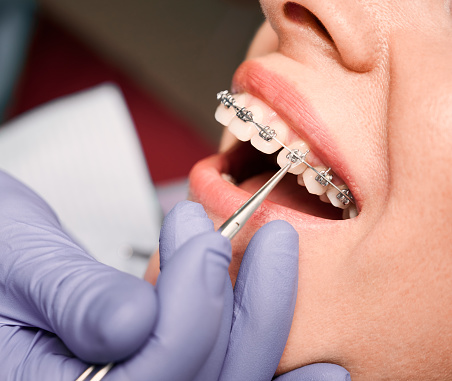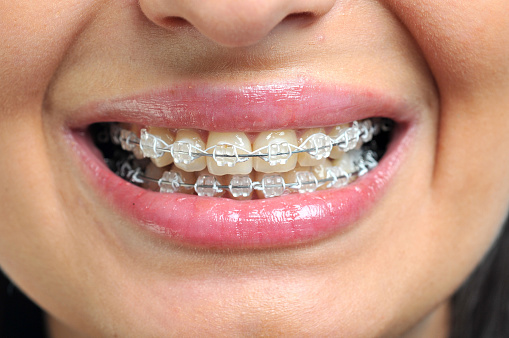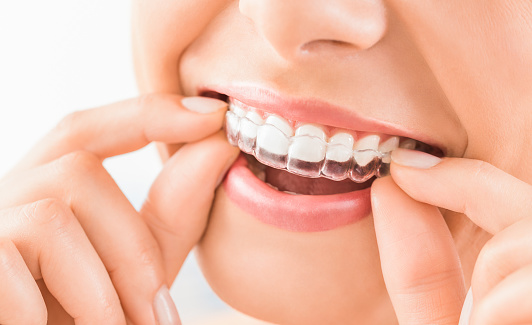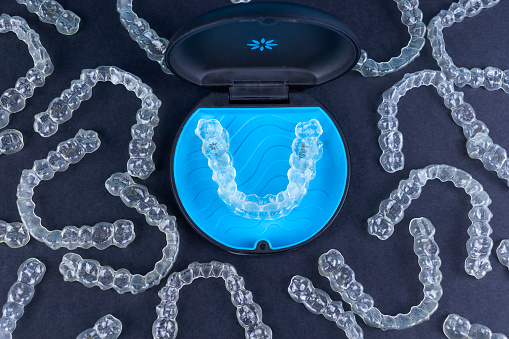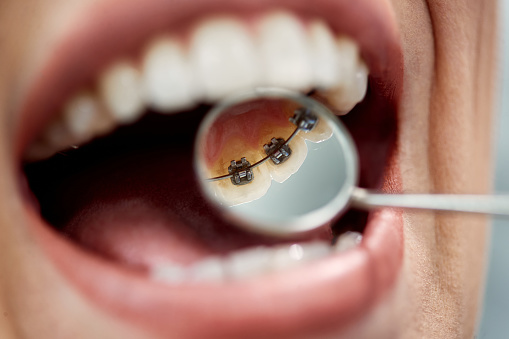All you need to know about
Braces for Teeth
Scroll down to know more about what are dental braces, when they are needed, types of braces, which one is more effective, how much do each type cost, degree of smile correction possible and the comparison of all types.
Orthodontic
Expensive
Multiple Visits
Some Pain
Cost of Dental Braces varies from
$
3,500
-
$
12,500
Quick Links
What are Braces?
What are Aligners?
Teeth Straightening
How do Braces work?
Types of Braces
Metal Braces
Ceramic Braces
Invisible Aligners
Lingual Braces
How to care for braces?
Are Braces Painful?
How long for dental braces?
Teeth Cleaning with Braces
What foods to/not to eat?
Cost of Braces
Overview
What are Braces?
Braces are dental appliances that can be used to align, straighten, or crowd teeth that are crowded, crooked, or out of place. Teenagers are frequently fitted with braces, but adults can also receive them. Braces gradually straighten and align your teeth so that you have a normal bite as you wear them. Some people get braces to adjust their smile.
There are numerous treatments that can help straighten teeth if you have crooked teeth and/or a misaligned bite (an underbite or overbite), including braces and retainers, which are specialised, removable or set devices that cover the exterior of your teeth and aid in maintaining their position.
Orthodontists specialise in fixing difficulties with your teeth, although many general dentists provide basic alignment and address other tooth concerns.
The dentist or orthodontist you choose will inquire about your health, do a clinical examination, digitally scan your teeth, take pictures of your face and teeth, and request head and mouth X-rays. They will use this information to develop a therapy strategy.
Perhaps all you need is a detachable retainer. But you might require surgery if you have a significant overbite or underbite. However, most people require braces.

Get Dental Braces now and Pay Later
Discounts & No Cost EMI plans on several popular dental treatments
What are Aligners?
Braces force teeth to shift by using brackets connected by wires. Aligners are placed over the teeth with a set of snug-fitting, custom-made mouthguards. The most common brand of clear aligners is Invisalign, but it's not the only one.
Aligners that are clear (or "invisible") aren't for everyone. You can select what's best for you with the assistance of your dentist or orthodontist. Inquire if they have expertise using aligners to treat patients. See reviews & testimonials on BrightPay or pictures showing the patients' transformations.

Can anyone get invisible teeth aligners?
The greatest candidates for the invisible aligners are adults or teens because they are made specifically for a tight fit. A child's teeth require more work to straighten. The clinician must keep in mind that young patients' mouths are still growing and developing when planning treatment.
Patients with mild to moderately crowded teeth or slight spacing concerns often utilise clear orthodontic aligners. Patients with significant crowding or spacing issues, as well as severe under-, over-, or crossbites, may require more involved care.
Teeth Straightening
Teeth straightening is the process of aligning and moving teeth into the proper position based on a person's bite over time using external force and pressure. Simply put, if you have crooked, misaligned, or misplaced teeth, they can be properly aligned again.
Why is teeth straightening required?
Straightening teeth is intended to improve dental health by correcting crooked teeth, underbites, overbites, deep bites, open bites, cross bites, teeth gaps, and other flaws of the teeth and jaw.
Cleaning in between crooked teeth can get very hard resulting in tooth decay and gum diseases.
They improve gum health creating a strong defense system against periodontal disease.
They help you chew your food well which is important for good digestion.
They improve facial appearance by lifting the mouth upwards, making the skin look firmer and younger.
Crowded Teeth
Before
After
Overbite
Before
After
Underbite
Before
After
Crossbite
Before
After
Open bite
Before
After
Gap in Teeth
Before
After
How do Braces work?
By applying consistent pressure to your teeth over an extended period of time, braces can reposition your teeth. Your jaw progressively changes to accommodate this pressure.
It can be difficult to understand that teeth can be shifted because we usually believe that they are directly attached to our jawbone. However, a membrane that connects your teeth to your jaw lies beneath your gums and is encircled by your bones. This membrane regulates how your teeth are positioned and reacts to the pressure that braces are applying to your teeth.
It usually doesn't hurt to get braces, during the appointment, and the process takes one to two hours. As you habituate, you could feel sore for the first week that you wear braces. You could have some soreness for a few days after each adjustment your orthodontist makes to your braces.
Bracket adhesion
Ceramic, plastic, or stainless steel brackets are glued to your teeth after they have been cleaned and allowed to dry. Although applying the brackets can be irritating, there is no pain involved.
These brackets will make it possible for pressure to be applied evenly to your teeth. Wires made of stainless steel, nickel titanium, or copper titanium connect and encircle them.
Bands
Once the brackets are attached to your teeth, elastic bands known as O-rings or ligatures are put around them. They are typical of the majority of conventional brace treatments and increase the strain on your jaw.
Spacers
Rubber bands or metal rings are used as spacers. During a visit, an orthodontist may insert them in the space between your molars. By creating more room at the rear of your mouth, spacers move your jaw forward. If the rear of your mouth is too narrow to accommodate braces, they also make room for them.
You don't always need spacers. Usually, they're only utilised for a week or two at a time.
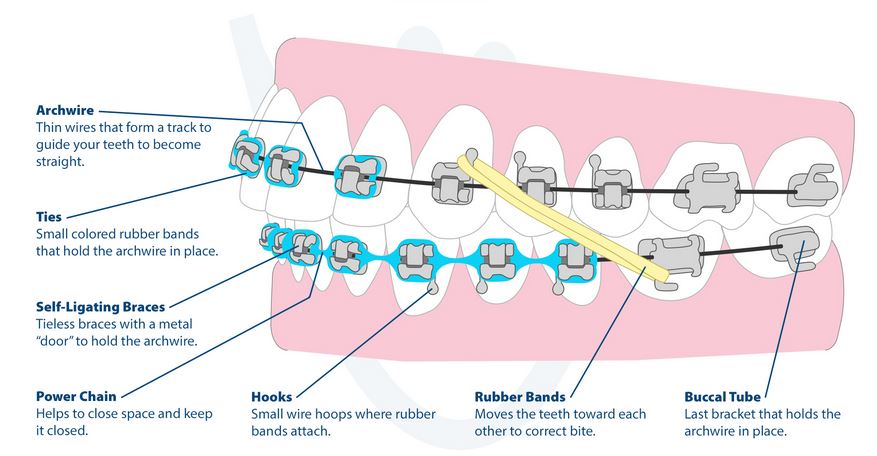
Archwires
The brackets on your teeth are connected by archwires. They serve as the means by which pressure is applied to cause your teeth to erupt. Stainless steel, nickel titanium, and copper titanium are all possible materials for archwire construction.
Springs
Your braces' archwire may occasionally be attached to coil springs. They press two of your teeth apart and create space by applying pressure between them.
How do Aligners work?
A dentist or orthodontist will create a plan for tooth movement once they've decided how to fix your bite. If you choose clear aligners, you will be fitted for a number of variations that gradually move your teeth over the course of therapy.
They are firmly fitted over the teeth and made of clear plastic or acrylic. However, they can be taken off for eating, cleaning, and flossing. Every few weeks, you'll receive a fresh set of aligners to keep shifting your teeth in the direction you want them to go.

Types of Braces
There are primarly 4 different types of Dental Braces, with a fifth type called Self-ligating braces which is a variant of Metal Braces
Metal Braces
Metal braces are constructed of stainless steel and nickel. They consist of flexible wires or arch wires that hold the brackets or bands together, as well as brackets that are cemented to the front of your teeth or bands that go around each tooth. Some braces also include metal ties or rubber bands connecting the brackets to the wire. These bands apply extra pressure, which aids in aligning and straightening your teeth. Your orthodontist may occasionally need you to wear headgear at night. It applies additional pressure to assist with tooth alignment. It is wearable and removable.
Ceramic Braces
Contrary to metal braces, which employ grey or metallic silver brackets and wires, ceramic braces use transparent or tooth-colored brackets. Because ceramic braces are less obvious on your teeth than metal braces, many individuals choose them. If you're thinking about getting braces and don't want to feel self-conscious wearing them, this might be a great benefit.
Invisible Aligners
Straightening teeth using Invisible aligners is an alternative to traditional braces. A system of transparent aligners customized made called Invisible braces cover your teeth and gradually move them into the right position. They are less apparent than conventional metal braces since they are transparent and removable. Adults and teenagers can both wear Invisible braces. In addition to correcting overbites, underbites, open bites, crossbites, and overcrowded teeth, these transparent braces are utilised to narrow spaces between teeth. We can decide if Invisible braces is the best orthodontic treatment for you after examining your teeth and taking x-rays of them.
Lingual Braces
Lingual braces are a type of invisible braces. Other invisible orthodontic appliances on the market are clear aligners or plastic or ceramic braces. But "lingual" braces are fixed to the back, or lingual side, of your teeth, closer to your tongue.
Care for Braces
How to care for braces?
1. Choose the Proper Toothpaste, Floss, and Mouth Rinse
Your dentist will inform you of the ideal toothpaste, floss, and mouthwash to use in order to get rid of the bacteria that might cause cavities, gum disease, or bad breath. Abrasive or harsh components are included in several oral health care brands, which might harm metal braces. You must choose a type of floss that will fit in between your teeth and along the bracket wires while you are making your selection.
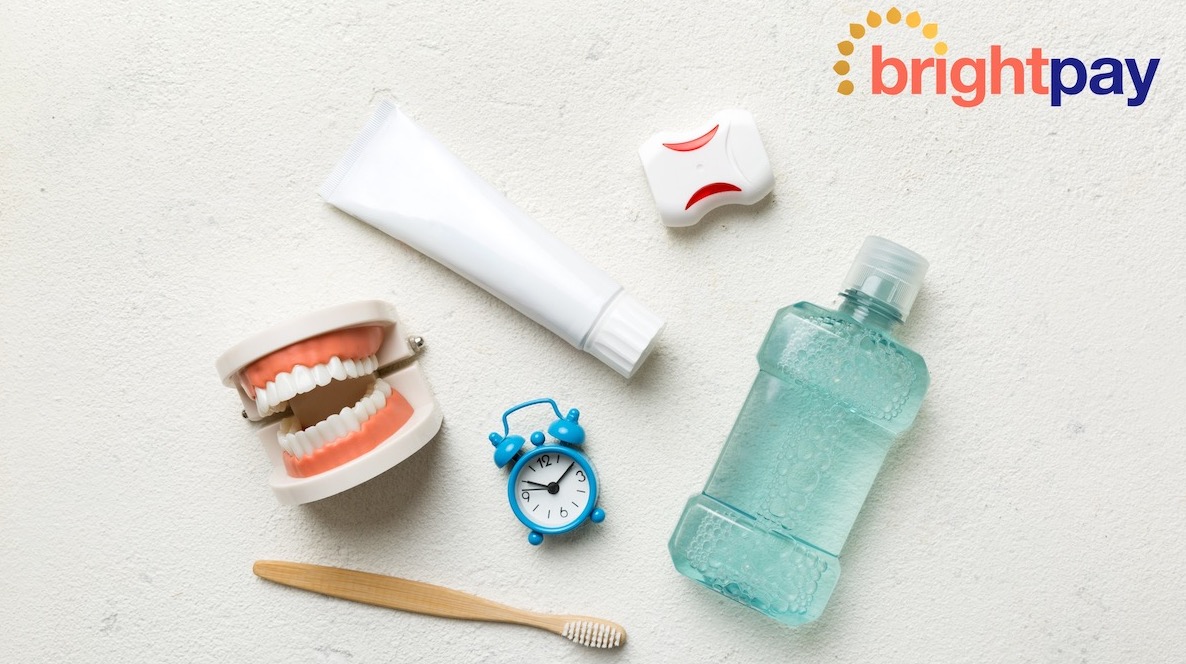
Using mouthwash is a great idea if you want to have fresh breath, but you must choose one without vivid red or green dyes that could stain the metal components or the removable elastics of your braces. To keep your metal braces in top shape, be sure to heed your orthodontist's advice on the best things to purchase.
2. Brush Your Teeth Regularly to Remove Food Lodging
When you have metal braces on, brushing your teeth is different because you have to be careful not to break the metal wires or knock a bracket out of place while also getting rid of all the food debris that has been left behind. Use mild pressure when brushing your teeth in addition to using a toothbrush with softer bristles that won't damage your braces. To safeguard your braces and have a bright smile, follow these instructions when brushing:

Rinse your mouth with water to remove loose food debris
Angle the toothbrush along the gums to remove the food that collects in this area
Use the angled motion again while brushing away food from the top of the brackets
Angle the toothbrush against the bottom of the brackets to brush upward
Brush every tooth in your mouth on the front and back to remove bacteria
You should regularly rinse your mouth with water to get rid of extra food that gets stuck in your braces and teeth from meals or snacks.
3. At Least Once a Day, Floss
You should use the precise kind of floss your orthodontist advised you to buy at least once every day after buying it. When flossing properly while wearing braces, issues like tooth decay and poor breath can be avoided. To correctly floss your teeth, follow these instructions:

Use floss thread or floss picks.
Reach the rear teeth in your mouth with a lengthy section of floss.
While flossing, stand in front of a mirror.
Put the floss between your teeth or beneath the wires using your fingertips.
Pulling on the floss when it is encased in a wire is not advised.
If a section of floss is covered in debris, switch to a new segment or a floss pick.
To avoid gingivitis, concentrate on clearing away food particles from the gum area.
After flossing, properly rinse your mouth to get rid of the loose particles.
4. Clean your teeth and braces using an oral irrigator.
You ought to buy an oral irrigator to clean your mouth of more plaque and food particles. In order to use this compact gadget, you must first fill its tank with fresh water by placing it on the bathroom counter. Food, germs, and plaque from your gums, teeth, and braces will be loosen by the moderate pressure water that is ejected from the water irrigator's tank by a wand. Instead of skipping brushing or flossing, you may easily supplement your dental hygiene routine with this device. If your orthodontist recommends it, you may only use an oral irrigator once a week for further cleaning.

5. Choose Your Diet Carefully
While you are wearing metal braces, you need to consume a lot of nutrients for your teeth, gums, and alveolar bones. For kids and teenagers, who are growing quickly, eating the greatest foods is extremely crucial. To preserve the wires and brackets on your braces, you should stay away from a few foods and drinks.

Your orthodontist will give you a list of foods to avoid after your metal braces are in place, including:
Hard nuts, such almonds or walnuts, might damage the wires in a brace.
Candy that is sticky, such as caramels or candy bars, is prohibited.
The hard kernels in popcorn can harm your braces.
Raw or fibrous veggies should not be consumed when wearing braces.
Bagels they're too chewy and firm.
The crunchy snacks of choice are corn chips.
Whole, raw fruit; stay away from pears and apples
Tough meat, including steak and pork chops
Peanut butter and other nut butters with a sticky consistency
You must consume soft meals that won't aggravate your gums, tongue, or palate after getting braces. Your mouth will become used to the metal braces after a few days, and you can start eating the foods that your orthodontist advises.
Are Braces Painful?
When getting braces fitted, you shouldn't experience much of a pain. However, you may feel uncomfortable in the days that follow the first installation as well as during and after modifications. During the first week after getting braces, you may experience:
pressure and soreness of your teeth and gums, especially when chewing
sores or pain on the insides of your checks
discomfort or cuts on your tongue (from running it across the new braces)
The discomfort from braces is described as a dull ache or throbbing. You can get relief from pain from wearing braces by using an over-the-counter painkiller, like as ibuprofen. For the first week, stick to soft, no-chew items like soup, yoghurt, and ice cream. Smoothies and cold beverages can also relieve sore gums.
In roughly a month, most people get used to their braces. You might not even notice them after a year. However, having a little soreness now and then is natural.
How long for dental braces?
Braces are typically worn for between one and three years on average. However, depending on your situation, you might require them for a shorter or longer period of time. Your treatment needs will determine how long you need to wear braces or aligners, but your actions may also have an impact.
The following factors could influence how long you need to wear braces.
How misaligned are your teeth?
Depending on the severity, you may need to wear braces for a different amount of time. For instance, to make more room in your mouth, teeth may need to be removed in order to realign your teeth.
Your bite
Your bite is defined by how your top and bottom teeth line up. You need treatment if your bite doesn't line up properly for one of the following bite types:
open bite
deep bite
underbite
cross bite
It can take longer to straighten teeth when the problem is with the bite than treating misaligned teeth
Types of braces
Depending on the type of braces, the length of the treatment varies significantly.
Lifestyle
To avoid wearing braces for an extended period of time, think about participating actively in your treatment plan. One can:
see your orthodontist for adjustments regularly
follow instructions for clear aligners and other appliances
visit your dentist every 6 months for cleanings
Additionally, discuss the best mouthguard to wear when exercising or participating in sports with your orthodontist. This can shield your braces and shield your mouth from harm.
Teeth Cleaning with Braces
Braces are dental appliances that can be used to align, straighten, or crowd teeth that are crowded, crooked, or out of place. Teenagers are frequently fitted with braces, but adults can also receive them. Braces gradually straighten and align your teeth so that you have a normal bite as you wear them. There are several treatments that can help straighten teeth if you have crooked teeth and/or a misaligned bite (an underbite or overbite), including braces and retainers, which are specialised, removable or set devices that cover the exterior of your teeth and aid in maintaining their position.
What foods to/not to eat?
Braces frequently cause discomfort after being initially fitted or tightened. Although this soreness will pass, it can initially make chewing and eating challenging.
Braces straighten teeth by exerting pressure, which may result in brief dental discomfort. Some may find that the first stiffness makes it difficult to bite down and chew.
While receiving orthodontic treatment, you'll feel less pain and sensitivity if you eat soft or liquid foods instead of chewy or firm ones. If you're in pain because of your braces, take these possibilities into account
10 Best foods to eat after getting braces
Yogurt/Curd
Oatmeal
Bananas
Mashed Potatoes
Jello
Eggs
Smoothies
Soups
Applesauce
Ice cream
What foods to avoid after getting braces?
Nuts
Hard food
Bagels
Candies
Gum
Pretzels
Bones
Popcorn
Ice
What if wire breaks?
Contact your orthodontist if a wire in your braces breaks.This is important for two reasons:
A break may negatively impact your treatment, because your wire is what applies the force that works to adjust your teeth and jaw
A broken archwire can lead to various complications, such as discomfort, cuts, and sores.
The course of action may include, but is not limited to, repairing a broken wire or entirely correcting a misaligned archwire administering medication if a bacterial infection exists
Cost of Braces
Cost of Braces

Get Dental Braces now and Pay Later
Discounts & No Cost EMI plans on several popular dental treatments
Post Treatment
Your orthodontist will probably recommend retainers once the active phase of treatment is over. The secret to sustaining the results of orthodontic treatment is to wear retainers as directed. You are in charge of maintaining the placement of the teeth that your orthodontist and you moved. The stability of therapy benefits over the long term depends on this "retention" phase of care.
Frequently Asked Questions about Dental Braces
